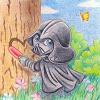But if you're just starting with your idea of an NPC mod, this is going to be useful.
Why am I writing this? Because I think that coding in .d is a really, really tedious and ungrateful work, which is why I think that every beginning NPC/romance/quest writer should know how to do it. And because it's That Simple.
It is easy, it will save time for you, and, if you are creating your mod with a help of a coder(or via "How to do this?" threads in IE Modding Help/Modding Q&A/your own forum), for others, too.
And if you've got your whole romance or NPC coded in perfect .d, finding a coder will be much easier - most of the work is already done.
So,
Talks with the PC: lovetalks, friend talks and more.
Let's take an example talk and code it. It's a romantic talk with Valygar.
A beautiful night. - Indeed. (to v5b.1) - But not the most romantic setting, is it? (to v5b.1) - Take my hand, and let us walk together under the stars. (to v5b.1) - Uh-huh. And a very quiet one. Damn, now I have to wipe my weapon again... (to v5b.1) (v5b.1) Shh. Can you hear it? An owl hooting - there! Here it flies off! A magnificent bird. - It shouldn't be here, right? (to v5b.2) - Perhaps it is someone's messenger. (to v5b.2) - Valygar, why are we discussing birds? (to v5b.3) (v5b.2) Owls are clever birds. It may be carrying messages... look, another one! A wizard must be living nearby. - Valygar, I implore you: don't start about wizards. Not now. (to v5b.4) - Or maybe they are courting. Just like we are. (to v5b.5) - I wonder... (to v5b.last) (v5b.3) (Valygar looks at you in amazement, then laughs.) Why indeed... (to v5b.last) (v5b.4) Hmm? No, I was thinking of - never mind. (to v5b.last) (v5b.5) We are not, <CHARNAME>. We are... (to v5b.last) (v5b.last) You must be tired. Take my hand, and let's walk. Enough battles for today.
Rule 1: Every line should start with a tilde (~) and end with a tilde(~).
This is the most important rule ever. If you ever get an error during the mod's installation, it's probably this one.
Let's implement it.
~A beautiful night.~ - ~Indeed.~ (to v5b.1) - ~But not the most romantic setting, is it?~ (to v5b.1) - ~Take my hand, and let us walk together under the stars.~ (to v5b.1) - ~Uh-huh. And a very quiet one. Damn, now I have to wipe my weapon again...~ (to v5b.1) (v5b.1) ~Shh. Can you hear it? An owl hooting - there!~ ~Here it flies off! A magnificent bird.~ - ~It shouldn't be here, right?~ (to v5b.2) - ~Perhaps it is someone's messenger.~ (to v5b.2) - ~Valygar, why are we discussing birds?~ (to v5b.3) (v5b.2) ~Owls are clever birds. It may be carrying messages... look, another one! A wizard must be living nearby.~ - ~Valygar, I implore you: don't start about wizards. Not now.~ (to v5b.4) - ~Or maybe they are courting. Just like we are.~ (to v5b.5) - ~I wonder...~ (to v5b.last) (v5b.3) ~(Valygar looks at you in amazement, then laughs.)~ ~Why indeed...~ (to v5b.last) (v5b.4) ~Hmm? No, I was thinking of - never mind.~ (to v5b.last) (v5b.5) ~We are not, <CHARNAME>. We are...~ (to v5b.last) (v5b.last) ~You must be tired. Take my hand, and let's walk. Enough battles for today.~
Rule 2: Every line NPC says should start with a SAY.
If NPC says several lines, all NPC lines after the one starting with SAY should start with an equals sign (=).
Easy enough? Let's see how it's going to look:
SAY ~A beautiful night.~ - ~Indeed.~ (to v5b.1) - ~But not the most romantic setting, is it?~ (to v5b.1) - ~Take my hand, and let us walk together under the stars.~ (to v5b.1) - ~Uh-huh. And a very quiet one. Damn, now I have to wipe my weapon again...~ (to v5b.1) (v5b.1) SAY ~Shh. Can you hear it? An owl hooting - there!~ = ~Here it flies off! A magnificent bird.~ - ~It shouldn't be here, right?~ (to v5b.2) - ~Perhaps it is someone's messenger.~ (to v5b.2) - ~Valygar, why are we discussing birds?~ (to v5b.3) (v5b.2) SAY ~Owls are clever birds. It may be carrying messages... look, another one! A wizard must be living nearby.~ - ~Valygar, I implore you: don't start about wizards. Not now.~ (to v5b.4) - ~Or maybe they are courting. Just like we are.~ (to v5b.5) - ~I wonder...~ (to v5b.last) (v5b.3) SAY ~(Valygar looks at you in amazement, then laughs.)~ = ~Why indeed...~ (to v5b.last) (v5b.4) SAY ~Hmm? No, I was thinking of - never mind.~ (to v5b.last) (v5b.5) SAY ~We are not, <CHARNAME>. We are...~ (to v5b.last) (v5b.last) SAY ~You must be tired. Take my hand, and let's walk. Enough battles for today.~
Rule 3: PC replies should look this way: ++ ~Reply~ + NPC_answers_this_line
Note: if a line only works under a special condition(PC is an elf, for example), the form changes to
+ ~condition~ + ~Reply~ + NPC_answers_this_line, as in
+ ~Race(Player1,ELF)~ + ~Reply~ + NPC_answers_this_line
Implementing this one should be easy, if a bit tedious. Coding in .d right from the beginning has its advantages...
SAY ~A beautiful night.~ ++ ~Indeed.~ + v5b.1 ++ ~But not the most romantic setting, is it?~ + v5b.1 ++ ~Take my hand, and let us walk together under the stars.~ + v5b.1 ++ ~Uh-huh. And a very quiet one. Damn, now I have to wipe my weapon again...~ + v5b.1 (v5b.1) SAY ~Shh. Can you hear it? An owl hooting - there!~ = ~Here it flies off! A magnificent bird.~ ++ ~It shouldn't be here, right?~ + v5b.2 ++ ~Perhaps it is someone's messenger.~ + v5b.2 ++ ~Valygar, why are we discussing birds?~ + v5b.3 (v5b.2) SAY ~Owls are clever birds. It may be carrying messages... look, another one! A wizard must be living nearby.~ ++ ~Valygar, I implore you: don't start about wizards. Not now.~ + v5b.4 ++ ~Or maybe they are courting. Just like we are.~ + v5b.5 ++ ~I wonder...~ + v5b.last (v5b.3) SAY ~(Valygar looks at you in amazement, then laughs.)~ = ~Why indeed...~ (to v5b.last) (v5b.4) SAY ~Hmm? No, I was thinking of - never mind.~ (to v5b.last) (v5b.5) SAY ~We are not, <CHARNAME>. We are...~ (to v5b.last) (v5b.last) SAY ~You must be tired. Take my hand, and let's walk. Enough battles for today.~
Rule 4: every block should have a unique name: IF ~~ block_name
"Unique" part is important, or you will get errors during the installation.
Easy? Easy.
IF ~~ v5b SAY ~A beautiful night.~ ++ ~Indeed.~ + v5b.1 ++ ~But not the most romantic setting, is it?~ + v5b.1 ++ ~Take my hand, and let us walk together under the stars.~ + v5b.1 ++ ~Uh-huh. And a very quiet one. Damn, now I have to wipe my weapon again...~ + v5b.1 IF ~~ v5b.1 SAY ~Shh. Can you hear it? An owl hooting - there!~ = ~Here it flies off! A magnificent bird.~ ++ ~It shouldn't be here, right?~ + v5b.2 ++ ~Perhaps it is someone's messenger.~ + v5b.2 ++ ~Valygar, why are we discussing birds?~ + v5b.3 IF ~~ v5b.2 SAY ~Owls are clever birds. It may be carrying messages... look, another one! A wizard must be living nearby.~ ++ ~Valygar, I implore you: don't start about wizards. Not now.~ + v5b.4 ++ ~Or maybe they are courting. Just like we are.~ + v5b.5 ++ ~I wonder...~ + v5b.last IF ~~ v5b.3 SAY ~(Valygar looks at you in amazement, then laughs.)~ = ~Why indeed...~ (to v5b.last) IF ~~ v5b.4 SAY ~Hmm? No, I was thinking of - never mind.~ (to v5b.last) IF ~~ v5b.5 SAY ~We are not, <CHARNAME>. We are...~ (to v5b.last) IF ~~ v5b.last SAY ~You must be tired. Take my hand, and let's walk. Enough battles for today.~
Rule 5: every block without PC replies should have either an ending, or an order to move to the next NPC line right under the NPC line.
An ending:
IF ~~ EXIT
An order to move to the next NPC line:
IF ~~ + name_of_the_next_NPC_line
Does it sound scary? No, not really. We had
SAY ~Hmm? No, I was thinking of - never mind.~ (to v5b.last), and now we are going to have
SAY ~Hmm? No, I was thinking of - never mind.~ IF ~~ + v5b.last, that's it.
So, our dialogue looks like this now:
IF ~~ v5b SAY ~A beautiful night.~ ++ ~Indeed.~ + v5b.1 ++ ~But not the most romantic setting, is it?~ + v5b.1 ++ ~Take my hand, and let us walk together under the stars.~ + v5b.1 ++ ~Uh-huh. And a very quiet one. Damn, now I have to wipe my weapon again...~ + v5b.1 IF ~~ v5b.1 SAY ~Shh. Can you hear it? An owl hooting - there!~ = ~Here it flies off! A magnificent bird.~ ++ ~It shouldn't be here, right?~ + v5b.2 ++ ~Perhaps it is someone's messenger.~ + v5b.2 ++ ~Valygar, why are we discussing birds?~ + v5b.3 IF ~~ v5b.2 SAY ~Owls are clever birds. It may be carrying messages... look, another one! A wizard must be living nearby.~ ++ ~Valygar, I implore you: don't start about wizards. Not now.~ + v5b.4 ++ ~Or maybe they are courting. Just like we are.~ + v5b.5 ++ ~I wonder...~ + v5b.last IF ~~ v5b.3 SAY ~(Valygar looks at you in amazement, then laughs.)~ = ~Why indeed...~ IF ~~ + v5b.last IF ~~ v5b.4 SAY ~Hmm? No, I was thinking of - never mind.~ IF ~~ + v5b.last IF ~~ v5b.5 SAY ~We are not, <CHARNAME>. We are...~ IF ~~ + v5b.last IF ~~ v5b.last SAY ~You must be tired. Take my hand, and let's walk. Enough battles for today.~ IF ~~ EXIT
Rule 6, final: Every block, with replies or without, should have an END.
This one is just a quick copy and paste:
IF ~~ v5b SAY ~A beautiful night.~ ++ ~Indeed.~ + v5b.1 ++ ~But not the most romantic setting, is it?~ + v5b.1 ++ ~Take my hand, and let us walk together under the stars.~ + v5b.1 ++ ~Uh-huh. And a very quiet one. Damn, now I have to wipe my weapon again...~ + v5b.1 END IF ~~ v5b.1 SAY ~Shh. Can you hear it? An owl hooting - there!~ = ~Here it flies off! A magnificent bird.~ ++ ~It shouldn't be here, right?~ + v5b.2 ++ ~Perhaps it is someone's messenger.~ + v5b.2 ++ ~Valygar, why are we discussing birds?~ + v5b.3 END IF ~~ v5b.2 SAY ~Owls are clever birds. It may be carrying messages... look, another one! A wizard must be living nearby.~ ++ ~Valygar, I implore you: don't start about wizards. Not now.~ + v5b.4 ++ ~Or maybe they are courting. Just like we are.~ + v5b.5 ++ ~I wonder...~ + v5b.last END IF ~~ v5b.3 SAY ~(Valygar looks at you in amazement, then laughs.)~ = ~Why indeed...~ IF ~~ + v5b.last END IF ~~ v5b.4 SAY ~Hmm? No, I was thinking of - never mind.~ IF ~~ + v5b.last END IF ~~ v5b.5 SAY ~We are not, <CHARNAME>. We are...~ IF ~~ + v5b.last END IF ~~ v5b.last SAY ~You must be tired. Take my hand, and let's walk. Enough battles for today.~ IF ~~ EXIT END
That's it! Coded.
Note that there is still one thing to do - setting the conditions for this lovetalk. To understand that, you'll have to read more on scripting in .baf, and how scripts work. If you want, you can start with:
1) A Beginner's Guide to NPC creation with WeiDU, and its expansion: How to make an NPC if you are a NOOB.
2) The road to banter - NPC-NPC dialogue, conditions, and more.
3) How to ensure your banters run when you want them to - that's scripting, quick and dirty.
(Or ask me or someone else to write another tutorial. AFTER you've coded your .d file, that is.
Bottom line: rules to remember.
Rule 1: Every line should start with a tilde (~) and end with a tilde(~).
Rule 2: Every line NPC says should start with a SAY.
If NPC says several lines, all NPC lines after the one starting with SAY should start with an equals sign (=).
Rule 3: PC replies should look this way: ++ ~Reply~ + NPC_answers_this_line
Rule 4: every block should have a unique name: IF ~~ block_name
Rule 5: every block without PC replies should have either an ending, or an order to move to the next NPC line right under the NPC line.
An ending:
IF ~~ EXIT
An order to move to the next NPC line:
IF ~~ + name_of_the_next_NPC_line
Rule 6, final: Every block, with replies or without, should have an END.
(And, yes, when I saw Weidu readme and some of the more advanced tutorials for the first time, I panicked, too, especially after I saw the "Don't panic!" note. My first piece of .d code for Branwen romance was created via taking constant peeks at jastey's work - Ajantis romance, in that case. Do not be afraid to borrow code - just bring in your own ideas.)
Edited by Kulyok, 22 March 2008 - 04:13 AM.














